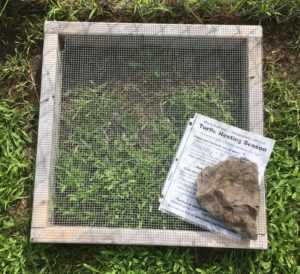Turtle, turtle, hey, hey, hey.
Claude Bégin
Turtles are fascinating cold-blooded reptiles. Slow growing and long-lived, they are among the oldest reptiles, dating back before the age of dinosaurs to more than 200 million years ago.
The greatest diversity of Canadian freshwater turtles can be found living in southern Ontario. There are approximately eight species commonly found in this province: painted turtle, snapping turtle, wood turtle, northern map turtle, spotted turtle, spiny softshell turtle, Blanding’s turtle, and Eastern musk turtle. Some of these species can be spotted living in and around Ottawa’s marshes, swamps, bogs, fens, wetlands, lakes and rivers. Here in the Sandy Hill area, species such as the snapping turtle and the painted turtle can occasionally be seen by the Rideau River at Strathcona Park.

Photo Claude Bégin
Female turtles usually lay at least one clutch of eggs per year, and this they do in the late spring or early summer. They can lay anywhere from 1 to 25 eggs, and these eggs take a couple of months to mature before hatching sometime in the late summer or early fall. Turtles do not nurture their young after hatching. The female turtle uses her rear flippers to dig a surface in either sand, mud, soil or gravel stone near a body of water to lay her eggs. She then covers them using her front flippers. The turtle then leaves and never sees the eggs again.
Unfortunately, due to predators, just a few of the eggs laid will actually hatch and grow into an adult turtle. However, as mother nature works in mysterious ways, turtle eggs end up being a highly nutritious food that mammals and birds can feed to their young. Raccoons, skunks, opossums, crows, ravens, foxes, and coyotes are among some of the animals that prey on turtle eggs.
Depending on the conditions of the environment and other factors like genetics and predators, turtles can live from 20 to over 100 years old. Being aquatic scavengers, turtles benefit ecosystems. They clean waterways by consuming dead and decaying fish or other animals. Between late fall and early spring, most turtles will be in a state of “brumation” (similar to hibernation): they bury themselves in the mud at the bottom of a body of water. They will enter an induced sleep until the weather is warm again. Most turtles are considered to be at some level of existential risk within the province of Ontario (one major contributor at play is habitat loss due to ever increasing urban development).
Fun Facts: Turtle or Tortoise?
A turtle has features that make it better adapted to life in the water. Its shell is thinner and more streamlined, and its feet are more webbed, making it easier to cruise through the water.
A tortoise, on the other hand, is more adapted for life spent on land. Its shell is more rounded and domed. The extra weight is carried by its club-like forelegs and elephantine hind legs.
Turtles are a fascinating thread in the web of life.

Illustration Claude Bégin
